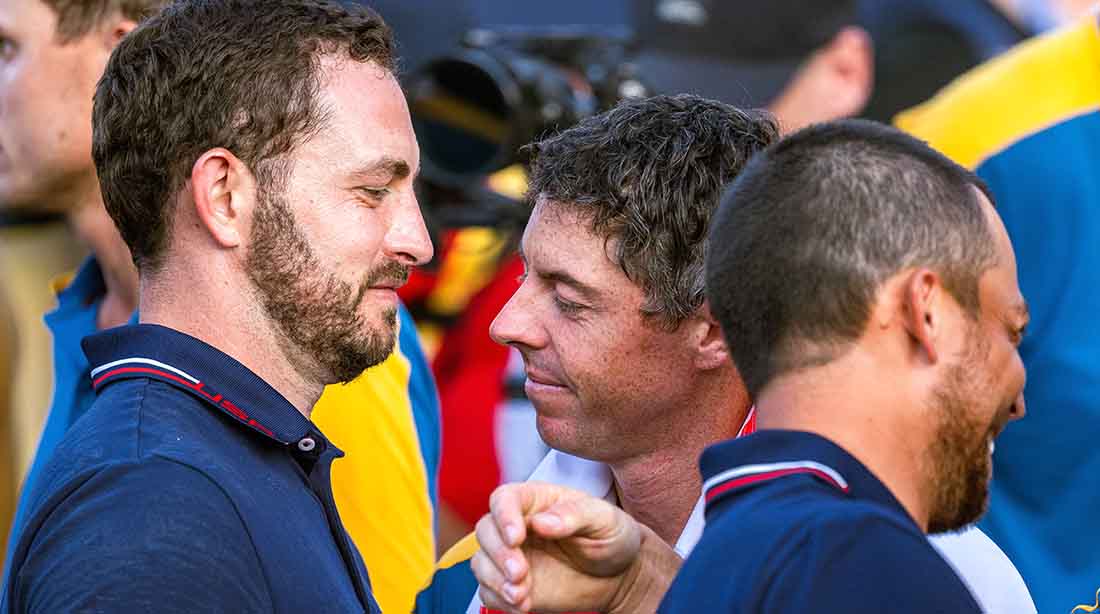The Ryder Cup Was Better When Matches Were Close and the Drama Was On the Course, Not Off It

Golf’s best little dramatic series has turned into a sitcom. One laugher after another, the story lines easy to recognize, the final outcome a foregone conclusion. Competitive suspense has succumbed to comedic gimmickry, which explains how a headline-hogging squabble can break out because one player didn’t wear a hat. Like most everything else on network television these days, a thickening plot has become a thing of the past. Same stuff, different cast.
Despite NBC’s repeated attempts to salvage the 44th Ryder Cup as an event worth watching, a flimsy screenplay prevailed once again. For the fifth consecutive time since 2014, the home team won by a margin of five points or more—blowout country regardless of which side of the Atlantic you favor. Europe has the only two road victories in the 21st century. Just twice in those 11 meetings has the verdict remained in question deep into the singles session.
“A scene that Americans have grown frustrated and tired of seeing,” NBC anchor Dan Hicks remarked as the celebration in Rome kicked into high gear late Sunday morning.

Given the six-hour time difference and all the audience-related restrictions that come with starting a live telecast at 1:30 a.m ET (5:30 for singles), this was, pun intended, a no-win scenario for NBC. Viewership in the western third of the United States will barely contribute to its overall ratings, which have fared no better than a standard PGA Tour event even when the Ryder Cup is held in the U.S. The 2021 affair at Whistling Straits posted a final-day 2.1 (3.51 million viewers). Europe’s coast-to-coast romp in France five years ago managed a meager 1.8 for what quickly became a meaningless collection of singles matches.
Routs ruin rooting interest. Five straight lopsided results? It should be serious cause for concern within the PGA of America and European Tour Group, the Ryder Cup’s two managing bodies. Central to the issue is the policy of granting home-team captains complete authority on course setup, which has altered the competitive dynamic far more than anyone might have imagined.
The Americans don’t hit enough fairways. The Euros struggle on fast greens. By allowing the host skipper to neutralize an opposition’s strengths and magnify its weaknesses, the intoxicating mix of match-play intensity and nationalistic fervor has suffered to the point where action is necessary. Until then, the Ryder Cup will remain a battle of analytics.
“Those numbers can measure a lot of things,” lead commentator Paul Azinger pointed out, “but they can’t measure heart.”
You can measure pulse, however, and Uncle Sam didn’t have one while getting swept in Friday’s opening session. The fast start extended Europe’s dominance in foursomes to a staggering 17–3 over the last three overseas clashes, all of which led to insurmountable U.S. crashes. It also made a genius of Euro captain Luke Donald, who moved the alternate-shot format into the leadoff spot in search of an early lead.
They don’t get any bigger than 4–0. “If I’m the United States, I’m going back to the drawing board,” Golf Channel’s Brandel Chamblee said on Sunday’s postgame Live From, where scrutiny is commonly delivered in bare-knuckled form. “I dare say that’s what the U.S. needs to do in foursomes. Dissect what the Europeans do. How do they match their players up? How do they set their golf courses up to complement their players? I don’t think the United States takes that part of it seriously enough [or] gets granular enough to take advantage of the strengths of their team.”
When 17–3 turned into 20–4 the following morning—Scottie Scheffler and Brooks Koepka, perhaps America’s two best players, fell 9 and 7 to Viktor Hovland and Ludvig Aberg—Europe led by seven and NBC had yet another beatdown on its hands. You can’t fool an audience by calling the glass half full for a squad that has won one of 12 matches, so when the Peacock’s first string came on the air for Saturday afternoon four-balls, Azinger did his level best to make things perfectly clear.
“The U.S. needs a sweep,” he said more than once. It sounded like an understatement more than a proclamation.
By sundown, Patrick Cantlay’s aversion to team-issue headwear had triggered a softcore skirmish between the battered Yanks and suddenly touchy Euros, whose lead would shrink to five. To say it blew the lid off the festivities would be rather hokey, but when video footage of Rory McIlroy venting his anger over a perceived breach of etiquette surfaced later that evening, you’d have sworn the fellas in blue and gold actually trailed by that same margin.
As only grim luck and shoddy reporting would have it, NBC botched its coverage of the incident. Shortly into the Sunday telecast, the network informed viewers that McIlroy and Joe LaCava, the two principals in the disagreement, had hooked up and made amends. After defeating Sam Burns in his singles bout, however, McIlroy tersely denied having met with LaCava in a brief post-round interview with NBC’s Cara Banks.
Given that Azinger had reprised the Mad Hatter matter several times during the Saturday broadcast—to the point where it became a clumsy digression—it made it incumbent on NBC to get the story right. That includes a report that Cantlay refused to wear a U.S. cap unless he was paid to do so, which remains a loose end with long legs. As for McIlroy later admitting that he’d exchanged texts with LaCava and settled their dispute, an episode no less silly than it was complicated mercifully reached closure.
Oh, and Europe won by five.
As both Azinger and Chamblee noted over the weekend, conflict and controversy are woven into the Ryder Cup fabric—essential materials in a series that has prospered amid a hotly contested whirl of spitfire and sportsmanship. What made the biennial matches such riveting television, however, is the edge-of-your-seat tension and pressure to perform on those rare Sunday afternoons when possession of the chalice is all that really matters.
Those Sundays aren’t so rare anymore. They’ve disappeared altogether.
